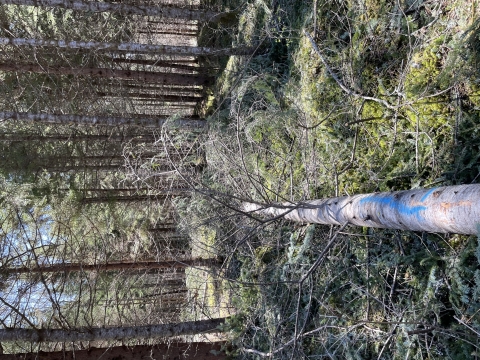Listen to this story HERE
“So when we go out there, you’ll see they're very evenly spaced, they’re almost all the same diameter, they’re all the same species, the canopy layer is all the same height. It looks very much like a plantation”
That's Jeremy Goetz, he's the forester for Nulhegan Basin Division of the Silvio O. Conte National Wildlife Refuge in Vermont. He’s talking about trees, now not just any trees, but the trees we were about to see when I visited the refuge forests in early May: uniformly planted balsam fir growing, roughly around the same height and width, in the ruts created by old logging machines.
In places, as Jeremy observed, it can look more like a farm than a forest, and that's because it once was -- in the 1800s, this low-lying forestland in the far northern corner of Vermont was a logging hotspot. Lumberjacks would spend freezing winters here, cutting down trees by day and sleeping in piles on the floors of chilly cabins at night. Come spring, the toughest of the bunch would float the logs down the Connecticut River and ride on top of them -- that was the fastest way to move the lumber from Vermont to the trading hubs in Massachusetts. While the stories of those days are amusing and fun, the legacy that they left forests of today is far more serious.
Decades of logging for one key species created the uniform balsam fir forest that dominates much of the Nulhegan today. That uniformity makes the ecosystem vulnerable to the variability of climate change climate change
Climate change includes both global warming driven by human-induced emissions of greenhouse gases and the resulting large-scale shifts in weather patterns. Though there have been previous periods of climatic change, since the mid-20th century humans have had an unprecedented impact on Earth's climate system and caused change on a global scale.
Learn more about climate change , whereas a diverse forest is full of species that each responds differently to the changes in temperature, precipitation, diseases, and pests. So now, managers are reconciling the harms of the past, while also preparing the forest to be more resilient to the harms of the future.
[Agius:] "So what we're trying to do is diversify, to bring in species that were previously here, that aren't here now, but we know that they're more resilient to a drier, warmer climate.”
That's Steve Agius. He's the refuge manager at the Nulhegan, and he’s working with Jeremy Goetz to oversee the refuge side of such a project:
“Specifically, what we’ve been looking at with this project is looking at is how we can work to restore the Nulhegan Basin, which has been heavily logged, for over 150 years, with an eye towards managing for biodiversity, but also understanding that climate change is going to impact this habitat.”
The project aims to increase diversity in the forest – so it’s no longer just middle-aged balsam fir after middle-aged balsam fir for acres. This should benefit wildlife conservation and climate change adaptation. So, to do that, they cut down a lot of trees and are planting a whole lot of new ones.
[Agius:] “We’re going back in and doing what’s called enrichment planting and bringing seedlings -- that’s what we’ve been working on for the better part of April, and now into May, we’ll be planting about 14000 seedlings: cedar, hemlock, red spruce, and white pine.”
Grace Smith, a technician at UVM [University of Vermont] is leading up that effort:
"So, tree planting: you want to get as close to the flag as you can go. Get the dibble in the ground, really as far as you can go. Open up a little pocket by shaking it back and forth. Then take the seedling. For some of them, like this one which has a crazy long root, we are trimming them because it’s better for the roots to be facing all the way down. Then, once it’s all situated, you’ll take the dibble about four inches or so out, make a second dibble hole to close the roots all in. Pull the dibble forward. Then, the last step, make sure the roots are all covered – they are. Make sure they look happy. And put a flag next to it so we can find it. And that’s tree planting! I hope it will grow up into a big beautiful pine.”
Grace wielded a clipboard with a grid of multicolored squares that meticulously map out where each species of seedling will go. The team needs this careful planning because it’s not just a restoration project for the Nulhegan, but a research project for the whole country; the results from this adaptive planting can hold lessons for other spruce-fir forests expected to get warmer and drier a with changing climate.
Tony D’Amato is the head of forestry at UVM and is the lead researcher:
“Really what we do is come up with a design that both meets our science interests but also really is a partnership with the management interests and the long-term goals for the site. Then we measure the heck out of it and replicate it and all these things that are probably a nuisance to the staff in terms of what the scientists want but really allow us to get robust information that we can track and recall over time about what might be ideal strategies for this landscape going into the future.”
So they have 550 acres for the experiment and three different types of treatments: the first is a simple control, the next is a density thinning, which means cutting down trees and leaving gaps, and the third is thinning and then planting of native trees that are well suited to the expected climate conditions. Wherever they cut down trees, harvesters left branches and logs to add even further structural diversity to the forest.
[Agius:] “What we’re trying to do is replicate some of these attributes that are found more often in more mature forests.”
[D’Amato:] “The key was to try to enhance the structural diversity and compositional complexity of those forests by creating gaps and creating multiple age classes. One of those treatments, the 15-acre unit, has three three-acre patch clear cuts: three three-acre openings with a lot of retrained trees within them, with the goal being, those trees we retained, mature trees create basically what you would see following a down burst of wind, kind of emulating that type of disturbance.
After the plantings are in the ground, monitoring will begin, and researchers will track how priority wildlife respond to these habitat changes and how the newly planted trees and forest itself will take to them.
[Agius:] So the name of the game is structural complexity, and that's going to benefit biodiversity. So what we're trying to do is pull out some of the balsam fir, recognizing it's a short-lived species and preferentially treat for red spruce, which is a longer-lived species. So with an eye towards climate change and understanding that we need to do what we can to capture carbon, we're trying to focus on longer-lived species and transition some of the refuge, but not all of it, to a late successional forest. So we're managing for early successional, mid successional, and late successional.
[D'Amato:] Really the goal is not the reengineer the Nulhegan’s forest; really the goal to Jeremy’s point and Steve’s point, is we’re just adding in some additional opportunities for adaptation over time, by putting these additional species out there.
As climate change forces land managers to reevaluate what it means to really protect habitat and wildlife resources, two main – and seemingly opposing -- approaches have emerged. There’s cut and dry restoration of returning a landscape back to historic conditions. And then there’s adaptive management, which helps a landscape become more resilient to preserve resources for future, changing climates. This project draws on both. It restores the forest to the ecosystem of the past, in order to make it more resilient for the future of climate change.
Simply by introducing a more diverse range of species, age groups, and wood fibers, a better balance will fall into place.
[D’Amato:]“This landscape is actually a legacy of only caring about one objective, which is fiber, so we learned a long time ago in forestry that is not a good scenario, we want a balance”
It’s a pretty fitting philosophy to have guiding this work, which at its heart, is a work of balance and cooperation between the Fish and Wildlife Service, UVM, and the busy team of planters on the ground. Everyone has their specialty, everyone has their niche—and in this diverse arrangement, the forest will thrive.





